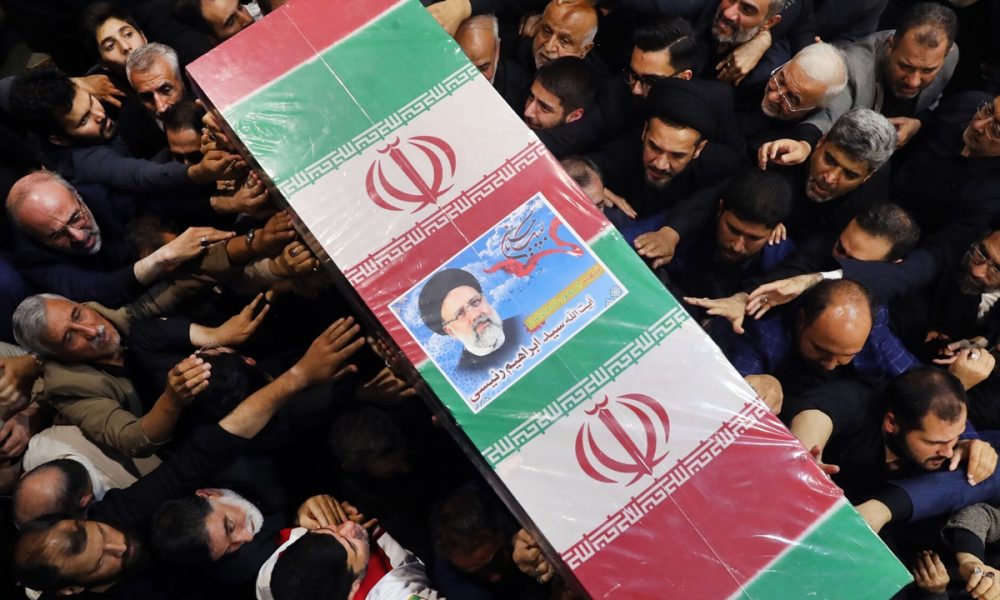OPINION
Iran’s future after president Raisi’s fatal helicopter crash

By Mohammad Mazhari
The recent helicopter crash involving senior Iranian officials, including President Ebrahim Raisi, Foreign Minister Hossein Amirabdollahian, and seven others, has cast a significant shadow over Iran’s political landscape, raising pressing questions about the country’s immediate political future and long-term stability.
Officials reported that Raisi and his associates were killed when the helicopter went down in heavy fog. While the cause of the crash remains unconfirmed, many observers and social media users have speculated about potential culprits—ranging from enemy countries and internal rivals to adverse weather conditions or a mechanical fault.
Under the Iranian constitution, should the president be incapacitated or deceased, the first vice president, Mohammad Mokhber, is mandated to assume the presidency temporarily until new elections can be held within 50 days.
Mokhber, a former officer in the Islamic Revolutionary Guard Corps (IRGC) and close ally of Supreme Leader Ali Khamenei is expected to maintain the current political trajectory. This is because the real power in Iran rests with the Supreme Leader, who exercises ultimate authority over the executive, judiciary, and legislative branches of government.
Raisi’s death intensifies speculation about his successor after a couple of low turnouts in recent parliamentary and presidential elections. With 59,310,307 eligible voters, the turnout in the 2021 presidential election was 48.8 percent, the lowest ever in Iranian presidential elections, below the previous low of 51 percent in 1989. Likewise, in parliamentary and Assembly of Experts elections which both took place on March 1, only 41% of voters came out; some 25 million cast their ballots out of Iran’s 61 million eligible voters.
This tragic event has undoubtedly plunged Iran into a period of uncertainty, with the upcoming elections likely to be a critical juncture for the nation’s future.
Early presidential elections can provide the Islamic Republic and the upper echelons of the state with a crucial opportunity to reverse course and reengage disillusioned voters. However, this requires a strategic decision to expand a political circle that has been steadily shrinking. So far, the political establishment’s inclination has been to double down on conservative rule.
The Guardian Council’s mass disqualifications, which barred prominent figures such as Ali Larijani, the former Speaker of Parliament, from competing in the presidential race, effectively paved the way for Ebrahim Raisi’s ascension to the presidency in 2021. This disqualification policy continued into the 2024 parliamentary and Assembly of Experts elections, in which former President Hassan Rouhani was banned from securing a seat in the Assembly of Experts.
Notable politicians who can be probable candidates for the presidency include Eshagh Jahangiri, the former First Vice President; Masoud Pezeshkian, a current legislator both from the reformist faction; Mohammad Bagher Ghalibaf, the current Speaker of Parliament; and most probably Mohammad Mokhber, the current interim president both are attributed to the conservative faction.
Should Ghalibaf or Mokhber who have close ties with IRGC, ascend to power, we can predict a consolidation of the IRGC’s influence in the state-run establishments. The IRGC controls vital portions of the economy and exerts considerable sway over military and security policies. The Generals will undoubtedly try to use the post-Raisi era to deepen their influence in the domestic milieu.
However, this trajectory has marginalized many top politicians and led to low voter turnout. It can pave the way for a new round of protests and destabilization in the country. The nationwide protests of 2022-2023, sparked by the death of Mahsa Amini, showcased the populace’s readiness to challenge the regime. These protests, led by a new generation of women demanding greater freedoms, were suppressed by the regime. With the economy in disarray and over sixty percent of Iranians living in poverty, the government’s legitimacy is severely strained. Raisi’s death adds another layer of instability to this already volatile situation.
The conservative government is already grappling with widespread discontent due to economic hardships, and Raisi’s death could trigger new protests, particularly if the upcoming presidential election is perceived as neither free nor fair.
Internationally, Raisi’s death might not significantly influence ongoing negotiations between Tehran and Washington or relations with the West, particularly concerning Iran’s controversial nuclear program. Known for his hardline stance, Raisi’s successor may have more space to navigate these complex issues using moderate policies amidst internal and external pressures.
Iran’s foreign policy remains under the Supreme Leader’s oversight, regardless of the political orientation of the dominant government. General policies and critical decisions in foreign policy must be approved by Ayatollah Khamenei.
Nevertheless, the Iranian regime faces a critical juncture. The Assembly of Experts, responsible for selecting the Supreme Leader, must carefully consider future leadership. The regime’s primary objectives are to rebuild its voter base, expand its military capabilities through the IRGC’s domestic and regional influence, and contain opposition forces.
Mohammad Mazhari is a political scientist who served as editor-in-chief of the Arabic Mehr News Agency from 2013-2020 and as a journalist at the Tehran Times from 2020-2021.
Twitter/X: @epicoria